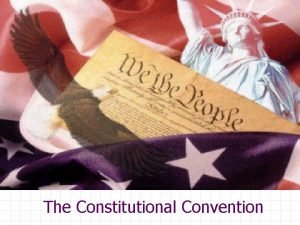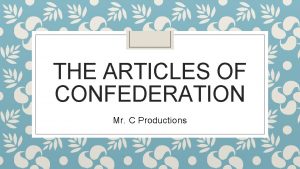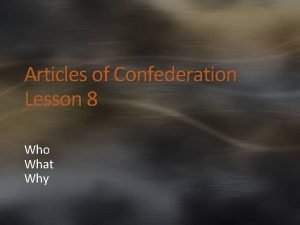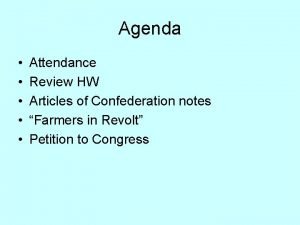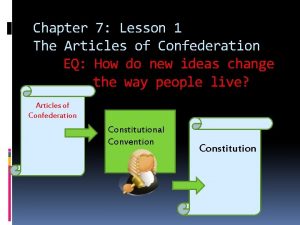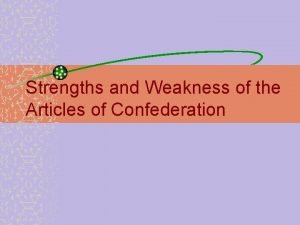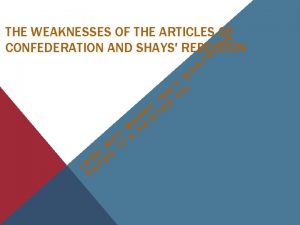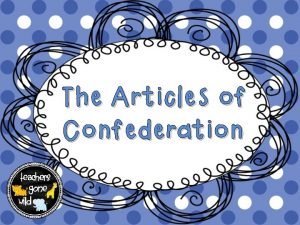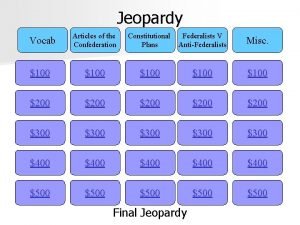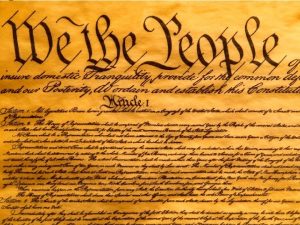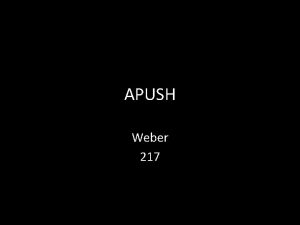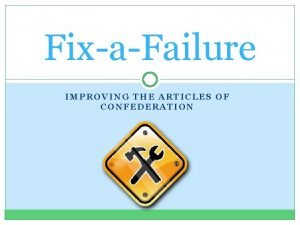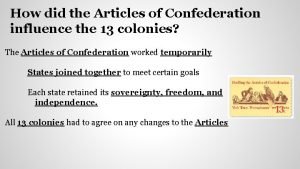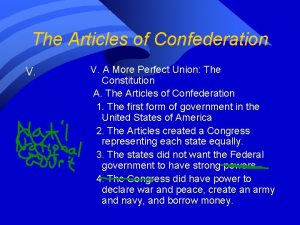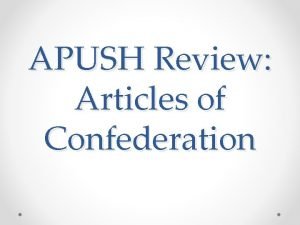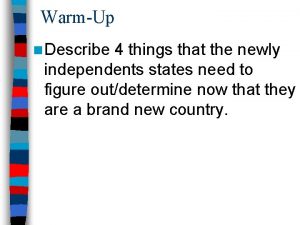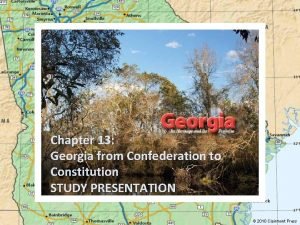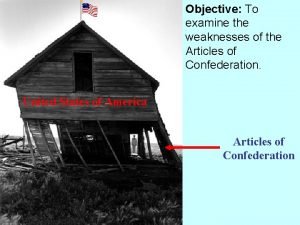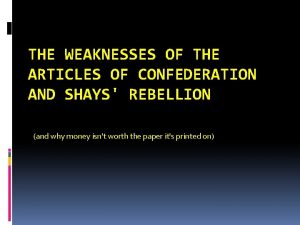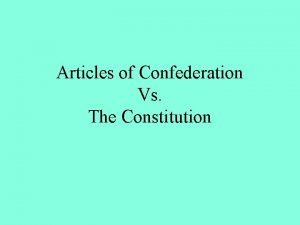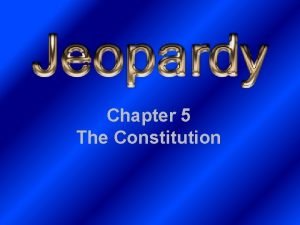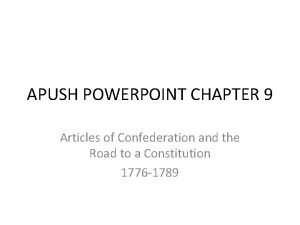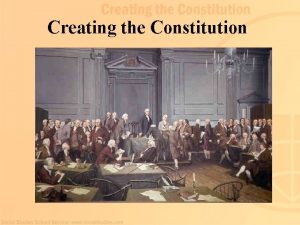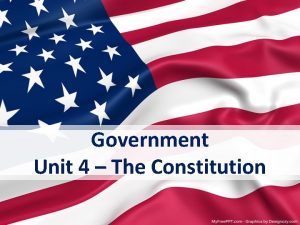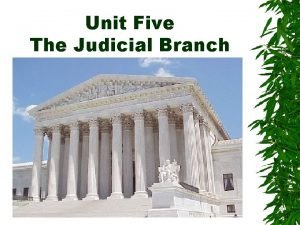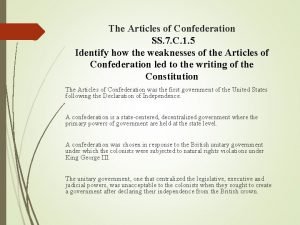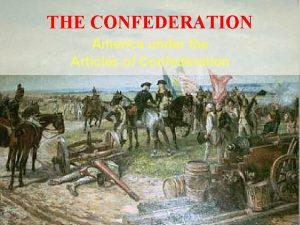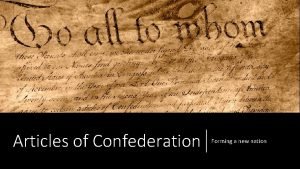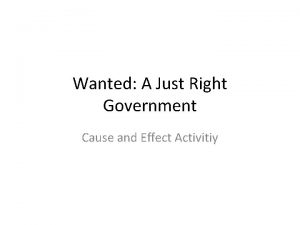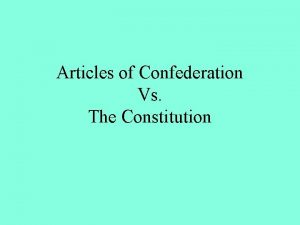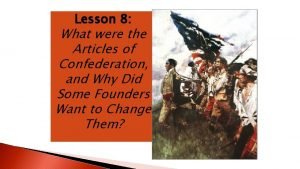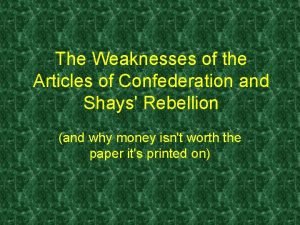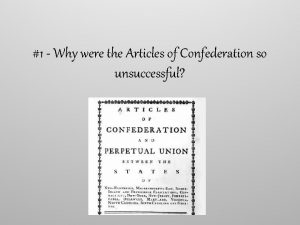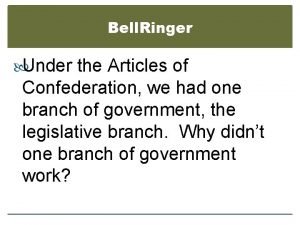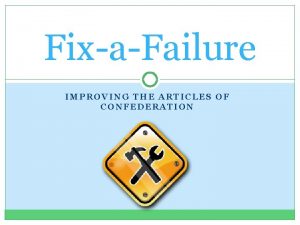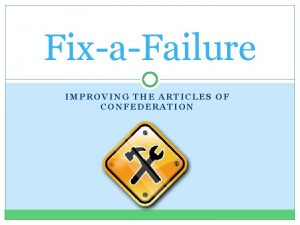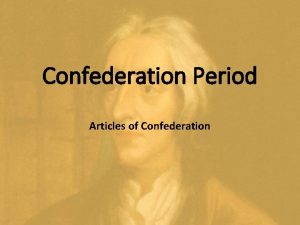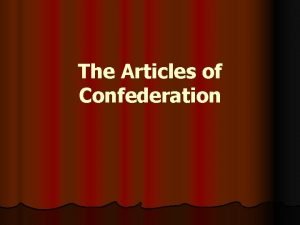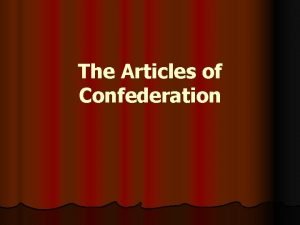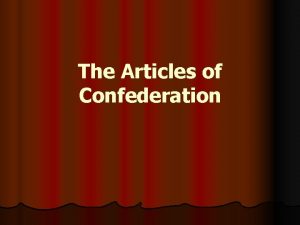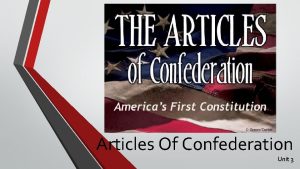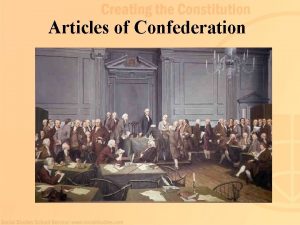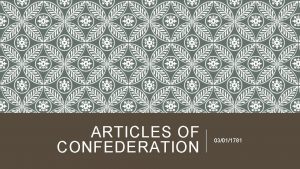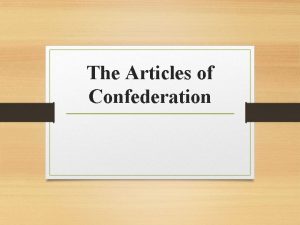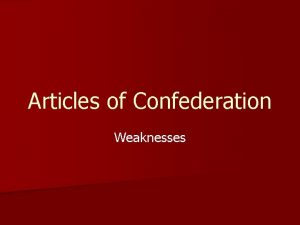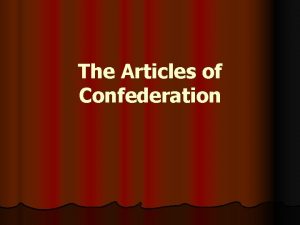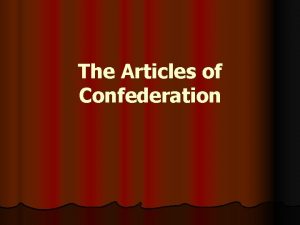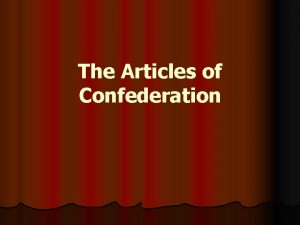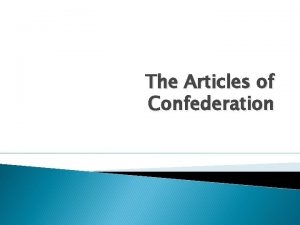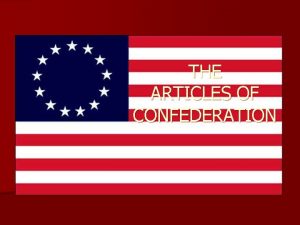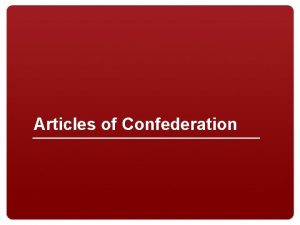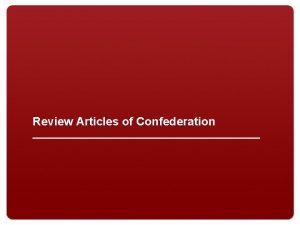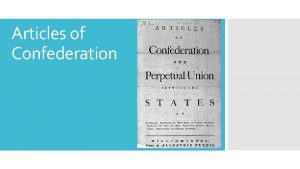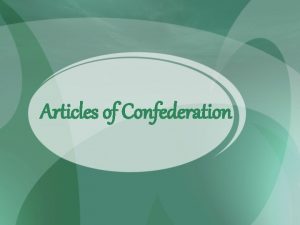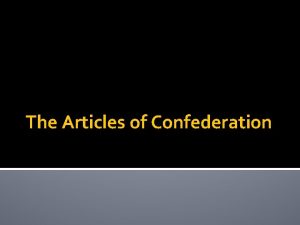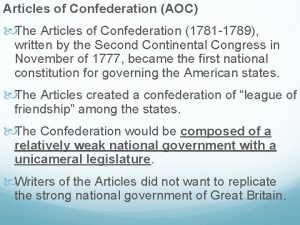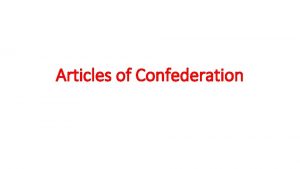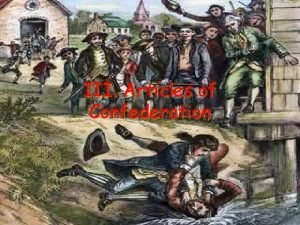FixaFailure IMPROVING THE ARTICLES OF CONFEDERATION Articles of


































- Slides: 34

Fix-a-Failure IMPROVING THE ARTICLES OF CONFEDERATION

Articles of Confederation �After winning our independence from Great Britain in the Revolutionary War, the new country needed to develop some form of governmental system. �Many wanted to be free of a strong central government. They saw themselves first as citizens of their states as opposed to the nation. States’ rights were an important issue. �The Articles of Confederation represented the first constitutional agreement made between the 13 American states. There was a need for unity among the new states that were created as a result of the American Revolution. � Ben’s Guide to Government

Confederation �The United States began as a confederation. �A confederation is… A group or league of independent states or nations united for a common purpose �The Articles of Confederation created a nation of pre-existing states rather than a government over individuals.

Articles of Confederation �Under the Articles of Confederation, the state governments retained most of the power. � The central or national government commanded little respect and was not able to accomplish much because it had little jurisdiction/power over states or individuals. States Nat’l Gov.

Problems with the Articles of Confederation �Under the Articles of Confederation, states often argued amongst themselves. They also refused to financially support the national government. The national government was powerless to enforce any acts it did pass. Some states began making agreements with foreign governments. Most had their own military. Most states printed their own money. There was no stable economy.

Shays’ Rebellion �A postwar depression had left many small farmers unable to pay their debts and threatened with mortgage foreclosures. � In western Massachusetts, a small band of farmers led by Captain Daniel Shays undertook a series of armed attacks on courthouses to prevent judges from foreclosing on farms.

Shays’ Rebellion �Shays’ Rebellion was the fiercest outbreak of public discontent in the new nation and demonstrated the weaknesses of the Articles of Confederation. �The rebellion convinced many states of the need for a stronger central government.

Change is Needed �As the economic and military weaknesses became apparent, people began asking for changes to the Articles of Confederation that would create a stronger national government.

Philadelphia Convention �At the urging of the states, Congress invited delegates from all of the states to Philadelphia �The purpose of this meeting was “for the sole and express purpose of revising the Articles of Confederation” Delegates (representatives of the states attending the convention) were only to revise the Articles… …but did they do more than revise?

Philadelphia Convention �Who was there? 55 delegates to the Philadelphia Convention All were white , male, landowners Delegates included: James Madison – had a plan for a stronger national government; the “Father of the Constitution” George Washington – highly respected; believed in a strong national government Photos from www. archives. gov Benjamin Franklin – one of the most respected men in America; primary role at the convention was to encourage cooperation among the delegates

Philadelphia Convention Met for four months in 1787 2. Proceedings held in secrecy 3. Problems with Articles of Confederation were so great the document was abandoned. 4. All states received one vote at the convention 1. This was done to please the small states who felt it was unfair to give more votes to the larger states Those who attended would be known as the “Framers, ” as they would be the ones to create the framework of the United States government in the Constitution.

Article Failures Problem Congress could not collect taxes. Implication No taxes=no money to run the country. States would not support the national government. X X X

Article Failures Problem There was no separate executive Implication branch for the central government ? National government was powerless to enforce any laws it passed; No President No checks and balances

Article Failures Problem �Congress had no power to enforce its own laws Implication in the states No enforcement= people in various states doing what they want

Article Failures Problem National government could not regulate trade between states. Implication States had their own trading practices and regulations with other states. This created slow and tense trade relationships.

Article Failures Problem Congress could not regulate foreign trade/commerce. Implication States were entering individually into trade agreements with foreign nations.

Article Failures Problem Citizens in states thought their property rights were being violated X Implication Violated property rights = tension between state governments and the people

Article Failures No court system to handle national/federal level issues Interstate issues would have no courts to go to on the federal level Federal laws but no federal courts? No checks and balances Problem There was no separate, national court system S I M G N I S Implication

Article Failures Problem The Articles required a unanimous vote to make changes to the Articles Implication This made it nearly impossible to make changes to the Articles; it could not be changed to match the current needs of the people

On Top of All Those Issues… �There were other looming issues facing the Framers: How would representation be addressed in the new constitution? Would large and small states all have the same voting power? How would the issue of slavery be addressed in the new constitution? Would slaves count towards the population of a state? How much power would be given to each branch of government?

Options �How did the Founders correct the problems in the Articles of Confederation? They tossed the Articles and started over! � Options considered: Virginia Plan • • • Proposed a strong national government State and national governments would exist, receiving their power from the people. National government would make and enforce their own laws and could tax the people Would have legislative (with a House and Senate), executive and judicial branches. Proportional representation New Jersey Plan • • Proposed a weak national government Congress could collect taxes on products and collect fines from the states if they refused to pay their taxes. Congress would have one house/chamber Each state would have equal representation

SCAVENGER HUNT! �Your mission: Hunt through the United States Constitution to find how the Framers fixed the problems presented by the Articles. Write where you found the “fix” - Article and Section Number and/or Amendment Number. You might find answers in more than one place! Then write a summary of what you found in the Constitution that fixed the problem

Fix-a-Fail HOW DID THE CONSTITUTION FIX THE FAILING ARTICLES?

Fix-a-Failure Problem Congress could not collect taxes. No taxes=no money to run the country How did the Constitution fix this problem? Article I, Section 8, Clause 1 “To lay and collect taxes…” X Translation: Congress has the power to set and collect taxes from the people.

Fix-a-Failure Problem There was no executive branch for the central government. ? How did the Constitution fix this problem? Article II, Section 1 “The executive Power shall be vested in a President of the United States of America” Translation: The power to execute the law will belong to the President of the United States of America.

Fix-a-Failure Problem �Congress had no power to enforce its own laws in the states. How did the Constitution fix this problem? Article II, Section 3 “…he shall take Care that the Laws be faithfully executed…” Translation: The duty of the executive branch is to make sure the laws are carried out/enforce.

Fix-a-Failure Problem Congress could not regulate trade between the states. How did the Constitution fix this problem? Article I, Section 8, Clause 3 “…to regulate Commerce…among the several States…” Translation: Congress has the power to regulate trade between the states.

Fix-a-Failure Problem Congress could not make states follow trade agreements with other nations How did the Constitution fix this problem? X Article I, Section 8, Clause 3 “To regulate commerce with foreign Nations…” Translation: Congress has the power to regulate trade with foreign countries.

Fix-a-Failure Problem Citizens in states thought their property rights were being violated X How did the Constitution fix this problem? Article VI “This Constitution…shall be the supreme Law of the Land…” Translation: No laws are above the Constitution; states should not make laws that conflict with the Constitution. Amendment IV “The right of the people to be secure in their persons, houses, papers, and effects against unreasonable searches and seizures…” Translation: The government cannot unfairly search personal property.

Fix-a-Failure Problem There was no national court system S I M G N I S How did the Constitution fix this problem? Article III “The judicial power of the United States shall be vested in one supreme Court, and in such inferior Courts as the Congress may from time to time ordain and establish. ” Translation: The Supreme Court is the highest court in the nation and there are lower courts that are created by Congress

Fix-a-Failure Problem The Articles required a unanimous vote to make changes to the Articles How did the Constitution fix this problem? Article V “The Congress, whenever two thirds of both houses deem it necessary, shall propose Amendments to this Constitution…shall be valid…as Part of this Constitution when ratified by the Legislatures of three fourths of the several States or by Conventions in three fourths thereof…” Translation: The Constitution can be changed if 2/3 of both houses of Congress think it’s necessary. It will be valid as part of the Constitution if ¾ of the state legislatures agree.

Representation Small States Large States � Feared large states would have � Felt their interests would not be more power if they were given votes based on population. � Wanted one vote per state. properly represented with one vote per state. � Wanted “proportional representation” or representation based on population. The Great Compromise (AKA The Connecticut Compromise) In order to appease both large and small states, the compromise was a bicameral legislature, or a legislature divided into two chambers: one with two representatives from each state (equal representation) and one with representation based on population (proportionate representation ).

Slavery Northern States � Most were opposed to slavery � Many were concerned about the Southern states counting slaves as part of their population thus giving them more representation in Congress. Southern States � Some were opposed to slavery, but many were financially dependent on slavery for farming purposes. � Believed that each state should have the right to choose for themselves. Without this choice, Southern states would not agree to be part of the union. The Compromise: The Framers agreed that the slave trade would not be ended prior to 1808. They also decided on the three fifths clause stating that population for the House of Representatives would be based on the total of free persons, indentured servants, and 3/5 of the slave population.

Power Struggle Executive Branch – Here is an �Concerns arose about how much power each branch Enforces the law example of of government would be given. checks and The President has the power to veto bills �Each branch of government would be given certain balances in action: outlined in the Constitution. proposed by Congress. powers Legislative � In addition to those powers, each branch. Judicial would. Branch be – Branch – Makes the law given certain “checks” they could do on the. Interprets other the law branches of government. For example: Legislative branch can pass a bill over the President’s veto with enough votes; may also re -word proposed bill and reintroduce The Supreme Court has the power of judicial review allowing them to declare laws of Congress or acts of the President unconstitutional.
 Weaknesses of articles of confederation
Weaknesses of articles of confederation Articles of confederation
Articles of confederation Lesson 8 the articles of confederation
Lesson 8 the articles of confederation Articles of confederation fail
Articles of confederation fail Chapter 7 lesson 1 the articles of confederation
Chapter 7 lesson 1 the articles of confederation Weakness and strengths of the articles of confederation
Weakness and strengths of the articles of confederation Achievements of the articles of confederation
Achievements of the articles of confederation Shays rebellion clipart
Shays rebellion clipart Articles of confederation jeopardy
Articles of confederation jeopardy What is the main idea of the articles of confederation
What is the main idea of the articles of confederation Articles of confederation apush
Articles of confederation apush Problems with articles of confederation
Problems with articles of confederation How did the articles of confederation fail
How did the articles of confederation fail Strengths of the articles of confederation
Strengths of the articles of confederation Articles of confederation
Articles of confederation Newburgh conspiracy apush
Newburgh conspiracy apush Congress acrostic poem
Congress acrostic poem Articles of confederation vs constitution
Articles of confederation vs constitution Failures of the articles of confederation
Failures of the articles of confederation Problems with articles of confederation
Problems with articles of confederation Articles of confederation vs constitution chart
Articles of confederation vs constitution chart Articles of confederation mnemonic
Articles of confederation mnemonic Articles of confederation apush
Articles of confederation apush Federalism in the constitution
Federalism in the constitution Articles of confederation vs constitution
Articles of confederation vs constitution Articles of confederation
Articles of confederation Articles of confederation weaknesses
Articles of confederation weaknesses Articles of confederation
Articles of confederation Articles of confederation
Articles of confederation A just right government cause and effect
A just right government cause and effect Constitution vs articles of confederation
Constitution vs articles of confederation Lesson 8 the articles of confederation
Lesson 8 the articles of confederation Articles of confederation strengths
Articles of confederation strengths Why were the articles of confederation unsuccessful
Why were the articles of confederation unsuccessful Articles of confederation bell ringer
Articles of confederation bell ringer
